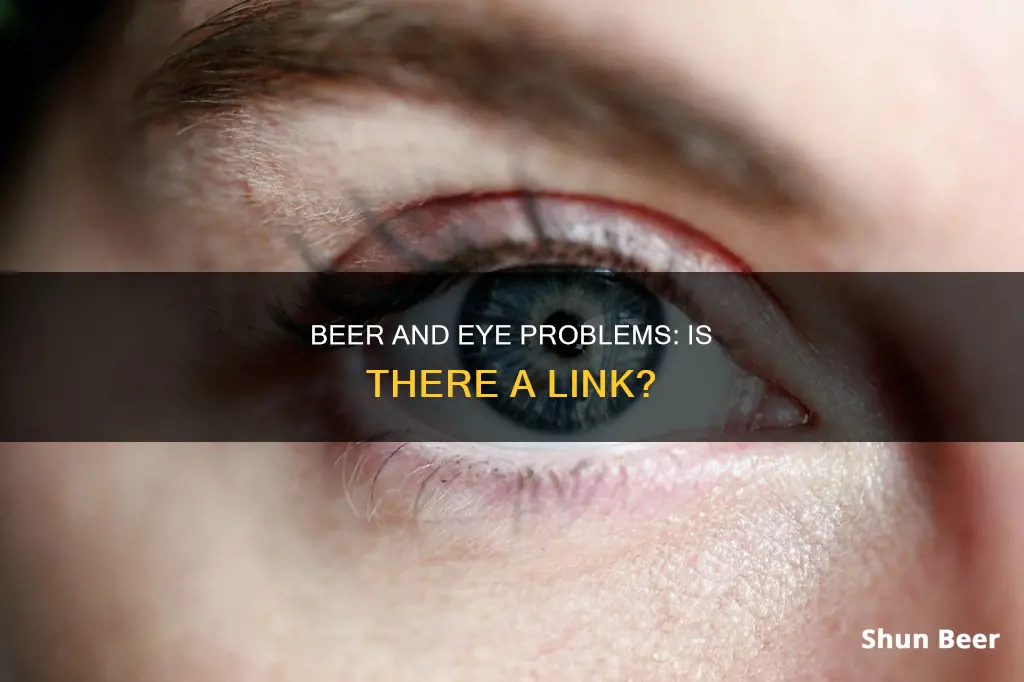
Alcohol consumption, especially in large amounts, can have harmful effects on the body, including the eyes. While occasional drinking in moderate amounts does not usually cause any health problems, heavy drinking can lead to several eye problems and even permanent vision loss.
Heavy drinking can cause blurred or double vision, red or bloodshot eyes, dry eyes, twitching or trouble focusing, involuntary eye movements, and decreased peripheral vision. It can also lead to more serious conditions such as optic nerve damage, toxic amblyopia, and age-related macular degeneration.
Alcohol affects the central nervous system and can alter the communication between the brain and the eyes, leading to impaired vision and slowed reaction time. It can also cause a delay in pupil reactions, making it dangerous to drive under the influence.
In addition, excessive alcohol consumption can lead to vitamin deficiencies, particularly Vitamin A and Vitamin B-1, which are important for eye health.
Therefore, it is important to drink in moderation and not exceed the recommended limits to prevent eye problems and maintain overall health.
| Characteristics | Values |
|---|---|
| Blurred vision | Temporary blurred vision is a common side effect of drinking alcohol. |
| Double vision | Alcohol diminishes communication between the eyes and the brain, causing double vision. |
| Eye twitching | Excessive alcohol consumption can cause eyelid twitching, also known as myokymia. |
| Trouble focusing | Alcohol reduces the reaction time of the pupils, leading to trouble focusing. |
| Involuntary eye movement | Long-term alcohol abuse can result in involuntary eye movements, causing discomfort and reduced vision. |
| Dry eyes | Alcohol is a diuretic, causing dehydration and dry eyes. |
| Bloodshot eyes | Alcohol causes the blood vessels in the eyes to swell, leading to a bloodshot appearance. |
| Optic nerve damage | Alcohol can damage the optic nerve, leading to low vision or blindness. |
| Loss of vision | Heavy drinking over time can lead to permanent loss of vision or blindness. |
| Headaches | Alcohol consumption can trigger migraine headaches, causing pain and discomfort. |
| Vitamin deficiency | Heavy drinking interferes with vitamin absorption in the liver, leading to eye damage. |
| Yellow sclera | Yellowing of the whites of the eyes (sclera) can indicate liver damage or disease from excessive drinking. |
| Cataracts | Alcohol can cause cataracts to develop earlier, leading to blurred vision and increased sensitivity to light. |
| Delayed pupil reaction | Alcohol slows down the reaction time of pupils, impairing vision when adjusting to lighting changes. |
What You'll Learn

Optic nerve damage
The optic nerve is responsible for sending impulses from the retina of the eye to the brain. A damaged optic nerve can lead to low vision and sometimes blindness. Optic nerve damage can also be very painful, leading to eye pain, eye floaters, loss of vision in one or both eyes, and loss of colour perception.
Alcohol- and tobacco-related optic neuropathy is an uncommon pathology, as it is more associated with pipe or cigar tobacco than cigarettes. However, alcoholism is usually associated with nutritional and vitamin deficits, which contribute to or predispose a patient to a greater extent of optic nerve toxicity. Therefore, alcohol, tobacco, and malnutrition are factors causing this type of optic neuropathy.
The main symptom of alcohol- and tobacco-related optic neuropathy is a painless loss of vision with an insidious onset that slowly advances. Initially, the patient notes blurriness in the central visual field, followed by reduced visual acuity, which may have a variable evolution. There is also a change in colour perception (dyschromatopsia).
In the examination of the back of the eye, the head of the optic nerve (optic papilla) usually appears normal in the early stages. After a variable period, the papillae gradually evolve, becoming pale. The whole optic nerve may become atrophied, with permanent loss of vision if tobacco and alcohol consumption are not stopped as soon as possible.
Treatment involves the immediate and permanent suspension of alcohol and tobacco consumption. On doing so, a gradual recovery and a slow improvement in visual issues are usually seen, unless the optic nerve damage is very severe and/or advanced. A healthy and balanced diet with vitamin supplements, including vitamin B12, is recommended.
Vegan Beer: What's in Your Drink?
You may want to see also

Involuntary eye movement
Excessive alcohol consumption can also lead to other eye problems, such as blurred or double vision, red or bloodshot eyes, dry eyes, and optic nerve damage. These issues are typically temporary and will resolve within 24 hours. However, long-term excessive drinking can cause permanent damage to the eyes, including vision loss and blindness.
Drinking Beer in Autzen Stadium: What's Allowed?
You may want to see also

Alcohol-induced toxic amblyopia
The condition is caused by damage to the papillomacular bundle of fibres, which results in impaired vision. The optic discs may appear normal, or show mild pallor. Other symptoms include central or cecocentral scotomas, peripapillary haemorrhages, and impaired colour vision. The disease is thought to be nutritional in origin, with most patients exhibiting signs of nutritional depletion. Improvement in visual acuity can be achieved through adequate dietary and vitamin intake, particularly B vitamins.
The condition was common before World War II, due to excessive drinking and tobacco use, but is now rarer, and usually only seen in people suffering from alcoholism. There is no treatment for toxic amblyopia, but low vision aids are available. The disease can take a few days to several weeks to develop, and once it starts progressing, it cannot be stopped. The main symptom is blind spots that gradually increase in size, eventually leading to total blindness.
Beer and Painkillers: Safe Mix or Not?
You may want to see also

Alcohol-induced migraines
Alcohol is also known to trigger migraines with visual aura. Visual aura is a temporary but debilitating symptom, which can cause greyed vision, blind spots, or zig-zag patterns of bright, shimmering lines of light across the visual field.
Alcohol is a common cause of vitamin deficiency, particularly vitamin A and B1. A vitamin A deficiency can lead to dry eyes, night blindness, retinal damage, and corneal perforation. A vitamin B1 deficiency can cause weakened or paralysed eye muscles. Both of these deficiencies can trigger migraines.
Alcohol also causes blood vessels in the eyes to expand and fill with blood, resulting in red or bloodshot eyes. This can cause itchiness and irritation, which may also trigger a migraine.
Finally, excessive alcohol consumption can lead to permanent loss of vision and blindness. This is caused by damage to the optic nerve, which sends impulses to the brain from the retina. A damaged optic nerve can cause eye pain, loss of colour perception, and vision loss in one or both eyes.
Beer Left Out: Is It Still Safe to Drink?
You may want to see also

Alcohol-induced vitamin deficiencies
Chronic alcoholics are frequently deficient in one or more vitamins, including folate, vitamin B6, thiamine, and vitamin A. Thiamine deficiency, also known as vitamin B1 deficiency, is common in people who drink excessive amounts of alcohol. Up to 80% of people with an addiction to alcohol develop thiamine deficiency. Heavy alcohol use causes inflammation of the stomach lining and digestive tract, reducing the body's ability to absorb vitamins. Thiamine deficiency can cause changes in heart rate, reduced reflexes, and a tingling sensation in the arms and legs. It can also lead to beriberi and Wernicke-Korsakoff syndrome, both of which can be fatal if left untreated.
Other vitamin deficiencies associated with alcoholism include low levels of vitamins B12, C, and E, as well as minerals such as magnesium, selenium, and zinc. These deficiencies can result in a range of neurological disorders and cognitive impairments, including impaired perceptual-motor skills, visual-spatial functions, learning and memory problems, and abstraction and problem-solving difficulties.
Nutritional therapy can aid in the recovery from alcoholism. Patients who received nutritional therapy reported significantly less alcohol craving and greater nutrient intakes, and a greater number abstained from alcohol.
Drinking Beer in Public in London: What's the Law?
You may want to see also







